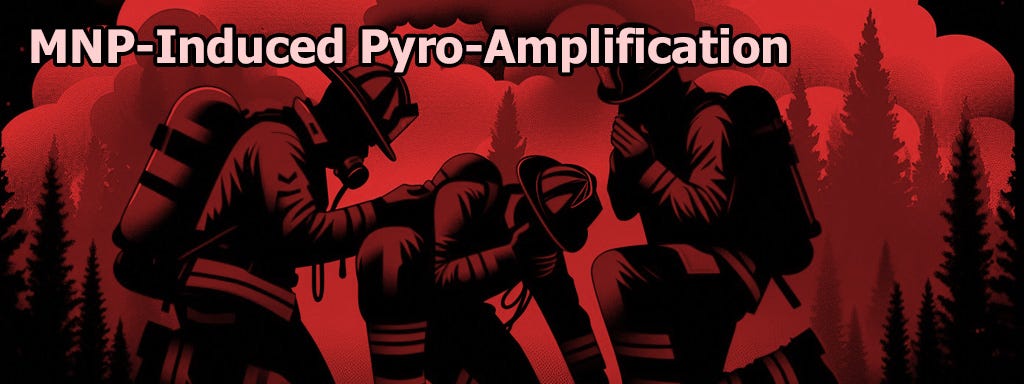“We may have all come on different ships, but we’re in the same boat now.” — Martin Luther King Jr.
A firefighter in California collapses after a shift. Lungs full of something that shouldn’t be there — not just smoke, but plastic vapor, dioxins, acid gases. The trees he tried to save had been drinking microplastics from the soil for years. That tree wasn’t just biomass. It was a Trojan horse. When it burned, it didn’t just release heat — it detonated a cloud of toxins.
Firefighters aren’t just battling flames anymore. They’re walking into a chemical ambush.
The Hidden Fuel Load
Micro- and nanoplastics (MNPs) have now been found inside plants — absorbed through roots and even drawn in through leaf stomata. Once there, they clog tissues, significantly slash photosynthesis and weaken the plant. Yields in staple crops drop 4–14% under MNP stress. Drier, weaker plants burn more easily.
But here’s what makes this catastrophic: plastics don’t burn like wood.
They ignite faster. They burn hotter. They drip flaming melt that spreads fire. And when they combust, they release a carcinogenic soup — ultrafine particulates laced with volatile organic compounds (VOCs), polycyclic aromatic hydrocarbons (PAHs), dioxins, furans, heavy metals, hydrogen cyanide, and acid gases.
The trajectory is devastatingly simple:
Soil 🌱 → Plants 🌿 → Synthetic fuel 🧪🔥 → Toxic smoke ☠️ → Firefighters 🚒 → Communities 🏘️
The Legacy Load
Here’s the acceleration curve no one is talking about: half of all plastic ever made was produced after 2000.
That wave is only now fragmenting into micro- and nanoplastics. The MNP burden in soils and plants will spike for decades, long after we stop making new plastic. We’re not at peak plastic-fire yet. We’re at the beginning of the curve.
Fire agencies are still typing ‘cellulose’ into spreadsheets while the forest burns like a tire fire. They calculate heat release rates, flame heights, and rate of spread based on cellulose and lignin — not polyethylene, polypropylene, and PVC. The models are already wrong. They’ll be catastrophically wrong by 2040.
📖 What We Know
Plastic uptake is confirmed. Plants absorb airborne and soil microplastics, translocating them into leaves, stems, and roots — the exact tissues that become wildfire fuel.
Combustion chemistry changes. Burning plastics release not just heat but a toxic cocktail that wildland firefighters aren’t equipped to handle. Structural firefighters wear SCBAs (self-contained breathing apparatus). Wildland crews wear cloth masks or nothing at all.
Exposure is cumulative. Ultrafine particles penetrate deep into lung tissue and cross into the bloodstream. Dioxins bioaccumulate. Career exposure means elevated cancer risk, neurological damage, and early mortality.
Downwind contamination spreads. Plastic-amplified smoke plumes travel hundreds of miles. The Camp Fire (2018) deposited toxic ash across Northern California. Maui (2023) left carcinogenic residue in drinking water systems.
❓ What We Don’t Know
How much plastic is already integrated into wildland vegetation fuels
Whether MNP-laden plants alter fire spread rates at landscape scales
The exact emissions profile when biomass and microplastics burn together in wildfire conditions
How many firefighter deaths and cancers are attributable to plastic-amplified smoke exposure
These aren’t academic questions. They’re body counts we can’t yet measure.
“The control of nature is a phrase conceived in arrogance, born of the Neanderthal age of biology and philosophy, when it was supposed that nature exists for the convenience of man.” — Rachel Carson
🔥 The Fires Are Already Different
California’s firestorms (2017, 2018, 2020). Australia’s Black Summer (2019–20). Canada (2023). Greece (2023). Maui (2023). The Amazon.
We’ve blamed climate change and drought — rightly. But there’s a third accelerant in the fuel load now. Agencies are starting to notice fragments of this problem:
Plastic debris in wildfires. Charred construction materials and household plastics fragment into microplastics that re-enter ecosystems. (California Ocean Protection Council)
Toxic chemical release. Plastic combustion spreads microplastics, additives, and toxic ash into soils, waterways, and food chains. (Plastic Pollution Coalition)
Health risks to firefighters. Wildland crews face respiratory hazards similar to structural firefighters, often without adequate protection. (Colorado Firefighter Trust)
But no one is connecting the dots: the plastic is inside the trees.
☣️ Cascading Collapse
Pyro-amplification is Pestilence spreading through fire — poisoning not just minds but lungs, soil, and air. This also fuels Famine: ash-contaminated farmland, ecosystem collapse through toxic cascade, pollinators dying in smoke zones. The Horsemen don’t ride alone.
We thought fire was just nature rebelling against us. Now it’s nature burning our trash back into our lungs and our plastic waste into our children’s brains.
Next time you smell that sweet-chemical campfire scent, understand: that isn’t just woodsmoke anymore. It’s grocery bags, IV lines, and our wasted century burning back through our lungs.



